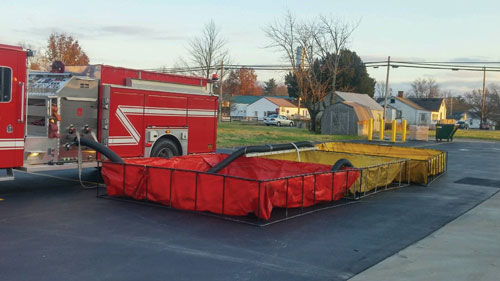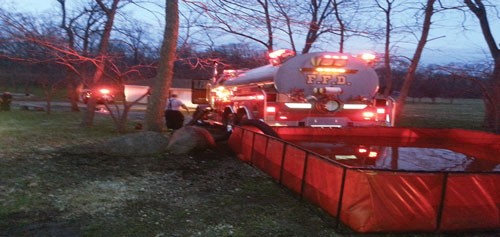
BY BILL ADKINS
In the fire service, there is always more than one way to conduct an operation, even in rural water movement. Like many firefighters, training officers, and chiefs, I have insisted on my way of conducting rural water movement operations as the best way for whatever reason. But the more we progress in the fire service, the more things change. The structures get bigger, and the contents burn faster and hotter. So I collaborated with other firefighters, training officers, and chiefs to research these tactics and discover the statistics on hydrant pressures, water flow with or without hydrants, and property preservation using these tactics.
In asking why departments used different water movement strategies and tactics, many replied “We’ve always done it that way” or “It works for us.” But budget constraints made the most sense to me. In the rural areas, budgets are bare minimum; many departments can’t afford all the fancy tools, gadgets, and apparatus. I hope to bring department chiefs and training officers together to strategically plan within their budget and capabilities how they want to conduct water movement.
I offer various strategies below and will assist you in picking the best strategy to get the job done safely and effectively. After that, just train again and again to ensure your department’s firefighters, officers, and mutual-aid departments know exactly what’s expected to conduct your water movement.
Mutual-aid departments? Yes, we are all on the same team. At a rural structure fire, you can be sure that some mutual-aid companies will assist for a successful outcome, so include them in your plans. Occasionally, they will show up around the same time the first-due companies are arriving on scene. You will expect them to set up your water movement strategy as if their members were your own. Give them the same respect when you respond to their incidents. Just because they don’t do it the same as your department doesn’t mean they are wrong.
Below are just a few of the many possible ways to conduct rural water movement along with each operation’s advantages and disadvantages and seating assignments. If you don’t see your strategy listed, it doesn’t mean it’s not one I find respectable.
First-Due Apparatus Drafting
This is the most common setup for many rural departments. The first-due engine company establishes its own water supply from a dump tank, a pond, or any other static water source. The water tankers/tenders shuttle in the water. This method requires fewer personnel than others. For smaller budgets, it is ideal because you need only one apparatus with a pump on the fireground and your tankers can be just plain water carriers, no pump needed (photo 1).
 |
| Photos by author. |
However, consider that you have only a few minutes until your first-due apparatus tank’s 500 to 1,000 gallons are gone to establish your water supply. If flowing 200 gallons per minute (gpm) from a 1,000-gallon tank, you will be out of water in around five minutes. The first-due operator must be proficient in establishing a draft and supplying the attack crews at the same time. Also consider that if the first-due apparatus has any type of mechanical failure, you must stop operations until another apparatus has replaced it.
Nurse Tankers
Nurse tankers supply the first-due apparatus with water and will establish their own water supply from a static water source. This is a quick way to give the first attack crews more water to extinguish the fire, so instead of having 500 to 1,000 gallons, the attack crew will have anywhere from 2,000 to 4,000 gallons of water or from 10 to 20 minutes of firefighting before they run out. Typically, the nurse tanker has established its water supply by this time. This technique also gives you two apparatus in case one has a mechanical failure. If one goes down, you will not lose water at the nozzle right away.

In this strategy, the first-due apparatus operator will set up as if the apparatus were pumping from a fire hydrant. The nurse tanker operator will start relay pumping to the first-due apparatus using its tank water until the first due establishes a water supply. The first-due apparatus operator will shut down its tank water once it starts receiving water from the nurse tanker (don’t forget to refill your water tank!). Once the nurse tanker has established a water supply, it will stop using its tank water (don’t forget to refill your tank!). By keeping both apparatus tanks full, you are creating a larger cushion if you need to wait for more tankers. The goal is to have the water coming from the static water supply through the nurse tanker to the first-due apparatus to the nozzle. (photos 2, 3).
Consider that this strategy necessitates that the two pump operators on the scene work together. Communication between them is paramount. Also, the tanker will have to stay on scene. Make sure other tankers are on the run cards when using this method. This strategy is normally used with larger budgets because it requires a tanker with a pump capacity equal to or larger than the first-due apparatus.
The Rural Hitch
The rural hitch allows the first-due apparatus to lay a supply line with a siamese wye or a large-diameter gated wye at the end of the driveway. The second-due apparatus lays a discharge line to the wye and supplies the first-due apparatus. For the third-due apparatus, a second discharge line can be set up to the wye (photo 4).

Once the supply apparatus tank is empty, its crew members must notify the first-due apparatus that they will disconnect. They will disconnect and fill from the nearest most reliable water source. Having a water supply officer at the wye appliance would be helpful in keeping the water supply running smoothly. Depending on the size of the incident, you may establish a static water supply if you need large volumes of water. Large tankers equipped with pumps are ideal for this operation.
Consider that you need multiple pump-equipped apparatus (pumpers or tankers) for this operation. If your department and your neighboring departments have budget restraints, this operation may not be feasible. This operation requires multiple pump operators and stellar communication between each of them.
The Jet Syphon
The jet syphon is not necessarily an operation; it is a technique for establishing a water supply from a static water source. Firefighters privileged to have hydrants every few hundred feet usually tell me if they had to draft from a static water source, they would hesitate. It’s an art that must be practiced often, or it will be lost.

When training these firefighters, I have found they prefer the jet syphon method over pulling the primer to establish their draft. If the firefighter is not accustomed to understanding the many sounds the primer makes, he will hesitate. However, if set up correctly, the jet syphon eliminates the need for the primer.
The jet syphon uses tank water to create an induction effect through the strainer to establish a prime. The jet syphon is set up the same as if the operator were going to use the primer. The strainer will have a ½- or a 2½-inch fitting to place a line coming from a selected pump discharge. The pump operator will open the selected discharge going to the strainer when he is ready to create the draft. The induction effect from the jet syphon will force water from the static water source into the inlet of the pump. It’s important for the pump operator not to run out of tank water prior to attempting the jet syphon method. I usually train operators not to go below a quarter of a tank before attempting the jet syphon method.
The First Five Minutes Matter
As firefighters, we all want to be on the nozzle even though we all know there are other jobs on the fireground that need attention. In a rural fire district, this becomes more complex – it’s not as simple as laying a supply line and hitting a hydrant. It depends on what staffing is available on each incident. It takes some teamwork in setting up for whatever water movement you choose.
I use seating assignments to manage these operations. Each person in the apparatus has a job to complete on arrival at the scene, including the following:
- The company officer completes the 360° survey, advises on strategy, and manages the crew. The engineer obviously works on operating the apparatus and establishing the water supply.
- One of the backstep firefighters pulls the attack line and operates the nozzle.
- The other backstep firefighter helps the operator set up the water supply.
Of course, each department may have different challenges; you can easily adjust this to fit your department.
This operation ensures all key roles are completed in a timely manner. Before implementing this operation, we had to stop progress to complete these tasks later. Once we established seating assignments, we eliminated fireground confusion and improved our skills and accuracy. Above all, our performance overwhelmed the community.
These are just a few ways to establish your rural water movement. There are still plenty of other techniques available: multiple dump tanks, vacuum tankers, dry hydrants, and single-lane drafting water supplies, to name a few. You may even decide to use two techniques at the same time. For example, with proper training, the rural hitch and a nurse tanker operation work great together.
Whatever technique you choose, take the time to train your peers along with your mutual-aid departments before you switch. If one firefighter, company officer, or chief arrives on scene and does not understand your chosen water movement strategy, expect problems on the fireground.
BILL ADKINS is a captain with the Loveland-Symmes (OH) Fire Department and an assistant chief and training officer with the Fayetteville (OH) Fire Department. He is a 22-year veteran of the fire service and the grandson of a firefighter, Cecil “Gene” Mains. He served in the U.S. Navy as a diesel mechanic and naval firefighter and with the Army National Guard as a mechanic. He is a certified fire instructor, an aircraft rescue firefighter, a rescue technician, a swiftwater technician II, and a dive rescue specialist.
Rural Water Supply: the Vacuum Tanker, the Better Way – Engine Company Operations
Firefighting Tactics: Throw Back to Basics: Rural Water Supply
Don’t Forget the Rural Fire Service
Fire Engineering Archives

